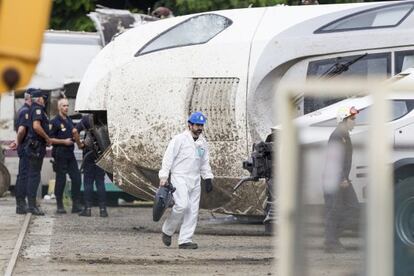Rail crash judge slams Adif for “playing with people’s lives”
Magistrate says reduction of safety systems on new high-speed track is “suspect of criminality”

The judge investigating the July 24 train crash near Santiago de Compostela, in which 79 people died, is targeting Adif, the state railway operator, for “playing with the lives of many people.”
The operator’s decision to open a high-speed link between Ourense and Santiago in 2010 on conventional railway tracks rather than high-speed ones, and the resulting reduction to safety systems, is “suspect of criminality,” said Judge Luis Aláez in his latest writ. “A lot of people’s lives were being played with, which implies that the transformation of the railway link should have come with additional safety measures.”
Besides asking experts for an assessment, the magistrate is also demanding testimony from the chief train driver at rail company Renfe, who alerted his superiors of the potential risk of an accident at the Angrois curve 18 months before it occurred.
The Alvia train — a hybrid model that can function at both regular and high speeds — took the curve at nearly twice the speed limit because the driver, Francisco José Garzón, forgot to brake in time. Garzón, who is the only person facing preliminary charges so far, said he was distracted by a phone call from his superior. The driver denied he had been consulting paperwork at the same time, something that investigators suspected after studying the train’s black box recorder.
More safety measures
Judge Aláez considers that this human error should have been foreseen and corrected with more safety measures than the ones available at the time. He also notes that the Ourense-Santiago link had originally been planned to open as a high-speed stretch with its corresponding width, yet it was inaugurated at the conventional, or “Iberian,” width. This entailed reducing the coverage of the ERTMS constant speed control system, which ends four kilometers before the Angrois curve.
The examining judge feels the decision to change the track width was “probably based on commercial motives” and that this benefit would not justify the risk increment, since “presumably the only use of that decision was to save a few minutes’ travel between Ourense and Santiago.” He also feels the board of Adif, whom he tried to bring in for questioning, must have been aware of the fact that modifying the track width would have been detrimental to passenger safety.
Tu suscripción se está usando en otro dispositivo
¿Quieres añadir otro usuario a tu suscripción?
Si continúas leyendo en este dispositivo, no se podrá leer en el otro.
FlechaTu suscripción se está usando en otro dispositivo y solo puedes acceder a EL PAÍS desde un dispositivo a la vez.
Si quieres compartir tu cuenta, cambia tu suscripción a la modalidad Premium, así podrás añadir otro usuario. Cada uno accederá con su propia cuenta de email, lo que os permitirá personalizar vuestra experiencia en EL PAÍS.
¿Tienes una suscripción de empresa? Accede aquí para contratar más cuentas.
En el caso de no saber quién está usando tu cuenta, te recomendamos cambiar tu contraseña aquí.
Si decides continuar compartiendo tu cuenta, este mensaje se mostrará en tu dispositivo y en el de la otra persona que está usando tu cuenta de forma indefinida, afectando a tu experiencia de lectura. Puedes consultar aquí los términos y condiciones de la suscripción digital.
Últimas noticias
Most viewed
- Alain Aspect, Nobel laureate in physics: ‘Einstein was so smart that he would have had to recognize quantum entanglement’
- Mexico’s missing people crisis casts a shadow over World Cup venue
- Why oil has been at the center of Venezuela-US conflicts for decades
- Trump clarifies who is ultimately in charge in Venezuela: ‘Me’
- Mexico seeks to shore up its defenses following US incursion in Venezuela








































